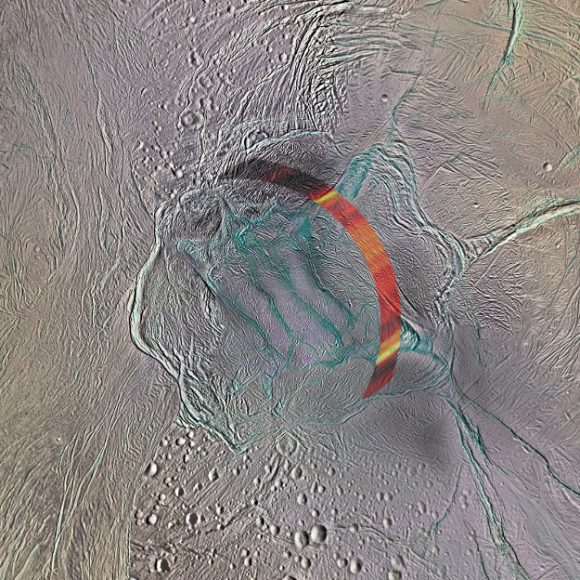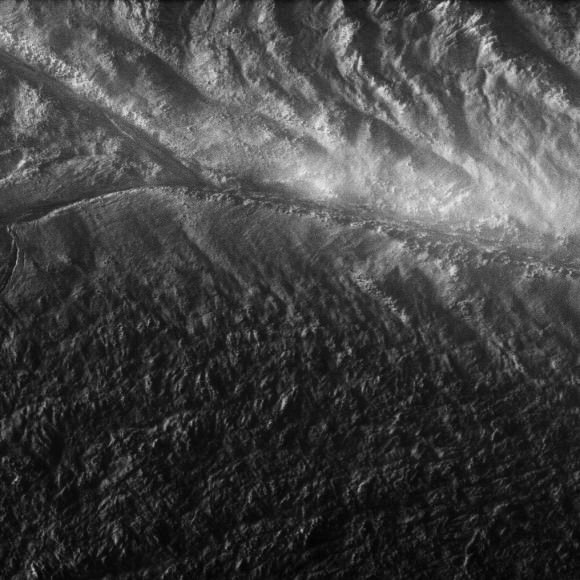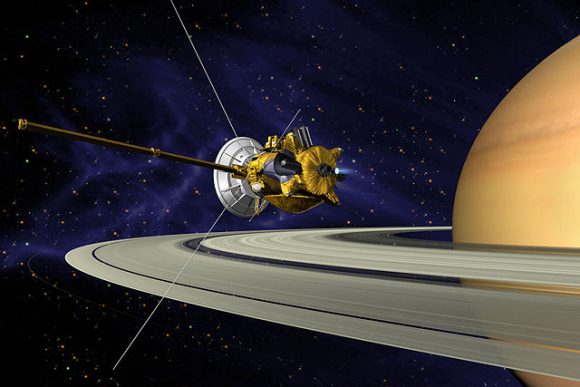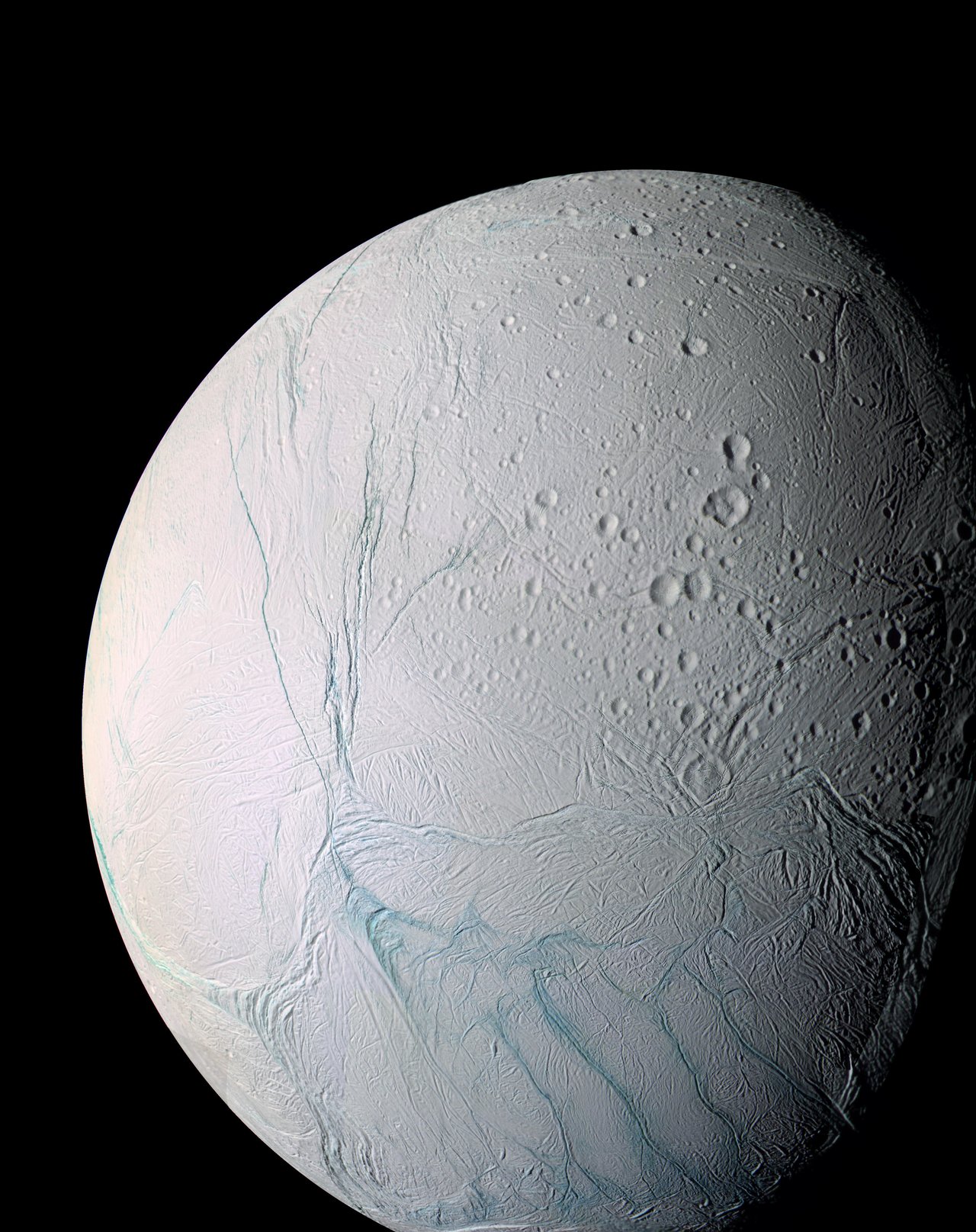One of the biggest surprises from the Cassini mission to Saturn has been the discovery of active geysers at the south pole of the moon Enceladus. At only about 500 km (310 miles) in diameter, the bright and ice-covered moon should be too small and too far from the Sun to be active. Instead, this little moon is one of the most geothermally active places in the Solar System.
Now, a new study from Cassini data shows that the south polar region of Enceladus is even warmer than expected just a few feet below its icy surface. While previous studies have confirmed an ocean of liquid water inside Enceladus which fuels the geysers, this new study shows the ocean is likely closer to the surface than previously thought. Additionally – and most enticing – there has to be a source of heat inside the moon that is not completely understood.
“These observations provide a unique insight into what is going on beneath the surface,” said Alice Le Gall, who is part of the Cassini RADAR instrument team, from Laboratoire Atmosphères, Milieux, Observations Spatiales (LATMOS), and Université Versailles Saint-Quentin (UVSQ), France. “They show that the first few meters below the surface of the area that we investigated, although at a glacial 50-60 K, are much warmer than we had expected: likely up to 20 K warmer in some places. This cannot be explained only as a result of the Sun’s illumination and, to a lesser extent, Saturn’s heating so there must be an additional source of heat.”

Microwave data taken during a close flyby in 2011 shows there is excess heat at three fractures in the surface of Enceladus. While similar to the so-called “tiger-stripe” features on this moon that are actively venting ice and water molecules into space, these three fractures don’t appear to be active, at least not in 2011.
Scientists say the seemingly dormant fractures lying above the moon’s warm, underground sea point to the dynamic character of Enceladus’ geology, suggesting the moon might have experienced several episodes of activity, in different places on its surface.
The 2011 flyby provided the first – and unfortunately, the only — high-resolution observations of Enceladus’ south pole at microwave wavelengths.
It looked at a narrow, arc-shaped swathe of the southern polar region, about 25 km (15 miles) wide, and located just 30 km to 50 km (18-30 miles) north of the tiger-stripe fractures.
The heat that was detected appears to be lying under a much colder layer of frost.
Because of operational constraints of the 2011 flyby, it was not possible to obtain microwave observations of the active fractures themselves. But this allowed the scientists to observe that the thermally anomalous terrains of Enceladus extend well beyond the tiger stripes.

Their findings show it is likely that the entire south pole region is warm underneath, meaning Enceladus’ ocean could be just 2 km under the moon’s icy surface in that area. The finding agrees with a 2016 study, led by another Cassini team member, Ondrej Cadek, which estimated the thickness of the crust on Enceladus’ south pole to be less than the rest of the moon. That study estimated the depth of the ice shell to be less than 5 km (1.2 miles) at the south pole, while average depth on other areas of Enceladus is between 18–22 km (11-13 miles).
What generates the internal heat at Enceladus? The main source of heat remains a mystery, but scientists think gravitational forces between Enceladus, Saturn, and another moon, Dione pull and flex Enceladus’ interior. Known as tidal forces, the tugging causes the moon’s interior to rub, creating friction and heat. It also creates stress compressions and deformations on the crust, leading to the formation of faults and fractures. This in turn creates more heat in the sub-surface layers. In this scenario, the thinner icy crust in the south pole region is subject to a larger tidal deformation that means more heat being created to help keep the underground water warm.

Since the geysers weren’t known until Cassini’s arrival at Saturn, the spacecraft didn’t have a specific payload to study them, but scientists used the instruments at their disposal to make the best observations they could, flying the spacecraft to within 49 km (30 miles) of the surface. To fully study the tidal heating — or to determine if there is another source of heat — scientists will continue to study the data already taken by various Cassini instruments. But since the mission will be ending in September 2017, it may require another mission to this intriguing moon to fully figure out this mystery.
“This discovery opens new perspectives to investigate the emergence of habitable conditions on the icy moons of the gas giant planets,” says Nicolas Altobelli, ESA’s Project Scientist for Cassini–Huygens. “If Enceladus’ underground sea is really as close to the surface as this study indicates, then a future mission to this moon carrying an ice-penetrating radar sounding instrument might be able to detect it.”
“Finding temperatures near these three inactive fractures that are unexpectedly higher than those outside them adds to the intrigue of Enceladus,” said Cassini Project Scientist Linda Spilker at the Jet Propulsion Laboratory. “What is the warm underground ocean really like and could life have evolved there? These questions remain to be answered by future missions to this ocean world.”
Feel free to submit your mission proposals in the comment section below…

Sources: ESA
JPL
Paper: Thermally anomalous features in the subsurface of Enceladus’s south polar terrain” by A. Le Gall et al. (2017), published in Nature Astronomy


How does the tidal friction hypothesis explain heating at only one pole?
Heating mostly occurs where the crust is thinnest, and when heated, it becomes even more flexible and more prone to tides, causing a runaway effect. Moons are stable only if the low-density areas are at the poles, so Enceladus turned over to place the ‘tiger stripes’ area at the nearest pole. It is likely an impact in the southern hemisphere created the initial thin crust, hence the flip to the south pole.
Am curious to know if the Cassini flyby was capable of detecting radionucleotides in the plumes? If so, then perhaps biologically mutanogenic properties might play a role in a rapid evolution of life? Or conversely put the kibosh on it entirely?
Oops.. that’s radionuclides.
We’ll need to wait until we go back to “taste” the plumes with dedicated instruments unless it’s buried in the data still.
The instruments on board Cassini are:
Cassini Plasma Spectrometer (CAPS)
Cosmic Dust Analyzer (CDA)
Ion and Neutral Mass Spectrometer (INMS)
Magnetometer (MAG)
Magnetospheric Imaging Instrument (MIMI)
Radio and Plasma Wave Science (RPWS)
From the Cassini web site(https://saturn.jpl.nasa.gov/science/enceladus/):
During a close flyby in 2008, Cassini’s instruments sampled the plume directly and detected a surprising mix of volatile gases, water vapor, carbon dioxide and carbon monoxide, as well as organic materials. The density of organic materials was about 20 times denser than expected.
This finding reminds me of the electric connection between Jupiter and Io. A similar connection may exist between the poles of Saturn and Enceladus. The additional heat that warms the south pole might be caused by electric discharge in dark current mode. If Cassini had gathered data about electric field and magnetic field around Enceladus, spatial variation of these fields should be investigated. I would expect that the same phenomenon may exist in the north pole, too. For a future mission, I would suggest observing the north pole to check if the same phenomenon exists there as well.